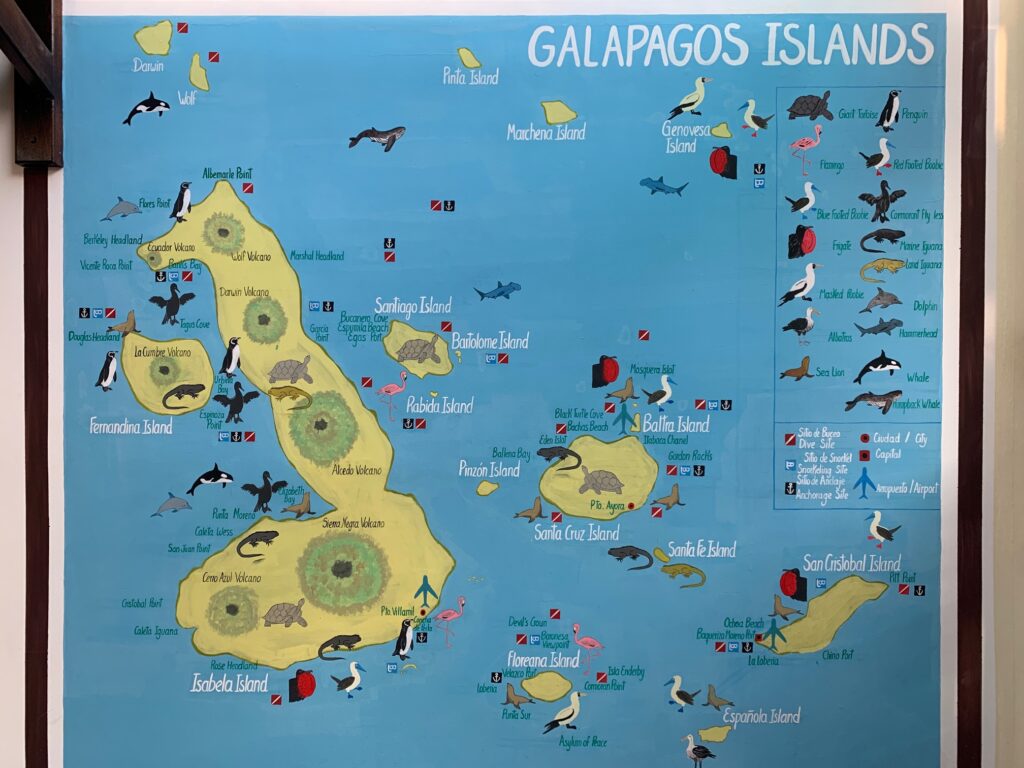Highlights
All the necessary information in planning a trip to the Galapagos. Here we detail:
- What is needed before going to the Galapagos. It is not as simple as hopping on the plane.
- How to travel between islands.
- How many days needed at each island.
- What to bring.
- The weather.
Time of Visit: April 2024
Duration of Visit: 10 Nights
Description
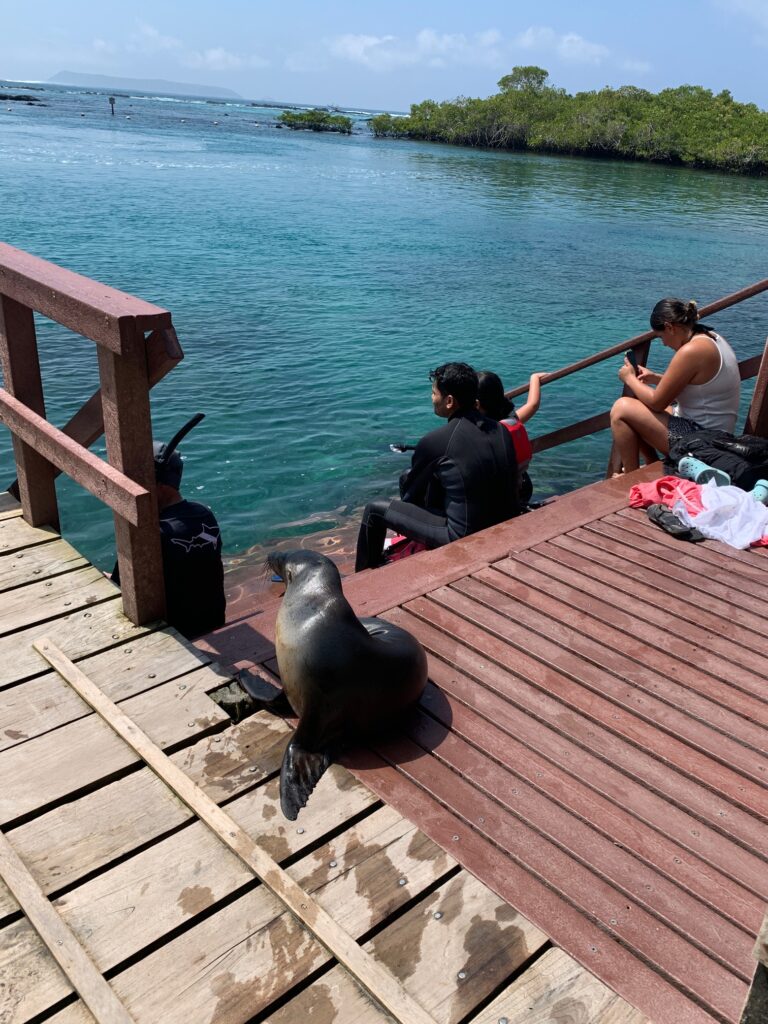

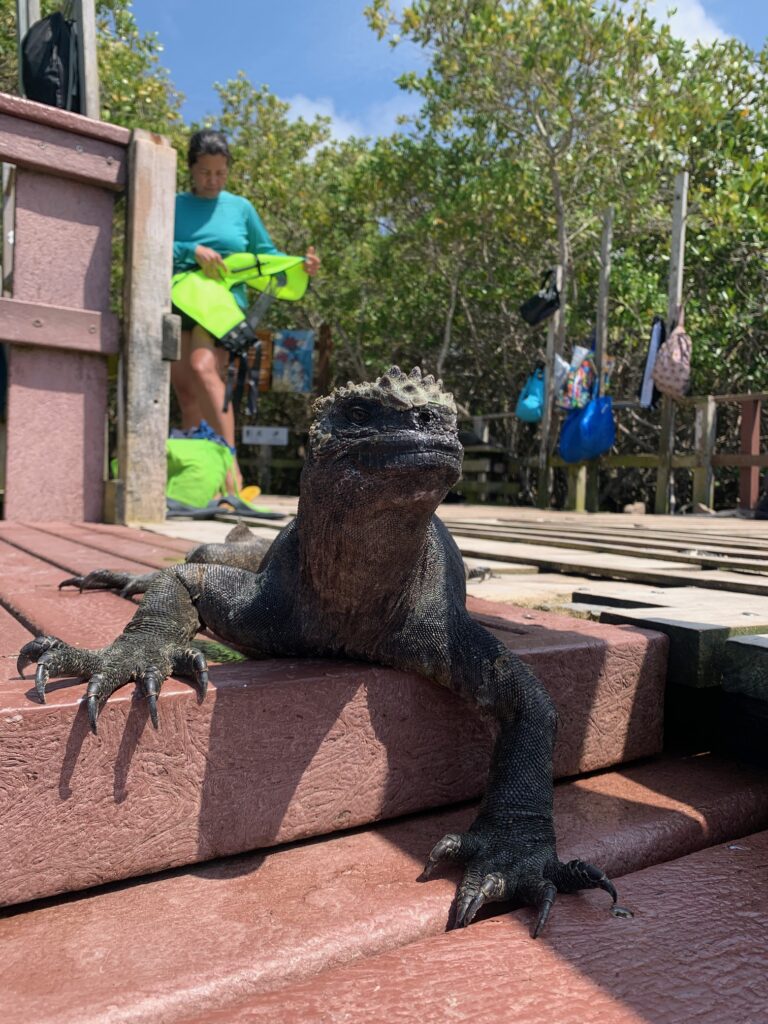

Galapagos is a unique place. It is one of the few places on earth where wild animals and humans co-exists. Most of the animals here have no fear of humans and happily go about their ways as if people were rocks. Iguanas just lay there motionless even if you step over them. Sea lions love to nap on benches and do not even flinch when people sit beside them for photos. Birds fly away and lizards scurry away only when you get too close. It is just fascinating.
The Galapagos is a group of islands in the Pacific Ocean that belongs to the country of Ecuador. It was made famous by the naturalist Charles Darwin in the 1800’s as providing the building blocks of his theory of evolution and natural selection. Ninety five percent of the Galapagos belongs to the national park. Four islands are inhabited while the rest are not.
The three largest Galapagos islands are Isabela, San Cristobal and Santa Cruz. These islands have permanent residents and where visitors can stay to explore the Galapagos. Floreana, which is south of Santa Cruz, is another inhabited island but with less than 200 residents. This is your island if you are OK with just the basics and just want to chill.
Today, the Galapagos is tourist and research destination. Visitors flock to the Galapagos to mainly see animals in its natural environment. It is common to see marine iguanas, pelicans, seals and sea lions at beaches, boardwalks and docks. They are not bothered by the presence of humans and just go about their ways. Inland, visitors may find the giant Galapagos tortoise that can live for more than 140 years. Inland birds are also plentiful. It is just like being in an outdoor zoo.
Cruise ships and boats are the only means of exploring the uninhabited islands. There are day tour boats but those cannot reach the outlying islands. Cruise ships can carry 100 guests while cruise boats have typically holds 16 to 20 guests. Cruising is very expensive, whether it is a boat or a ship. The cost gets higher, the more modern the vessel.
How Many Days In The Galapagos?
The answer to the question really depends on where you want to go and what you want to do. We think three nights each at Isabela, San Cristobal and Santa Cruz may be enough to see what each island offers without getting on any day tours. Add a day for each tour activity. There are plenty of tours offered at these islands.
We listed some of the activities you can do on your own in Isabela, San Cristobal and Santa Cruz so you can determine how many nights you may need on each island. If you want to visit Floreana, a couple of locals we talked to said that one night would be enough as there is nothing to do.
Is The Galapagos Affordable?
We think it is very affordable if you are not doing any tours. Tours are expensive here. A day tour can be anywhere between $150 and $300 pp or more depending on the activity. Dive tours are also expensive, around $200 – $250 pp, normally involving just two dives.
Lodging has a wide range depending on the facility. It is not uncommon to find a decent hotel in the $60 range per night. Hostels offer an even cheaper option.
Ignoring tours for the meantime, the only unknown costs are food, inter-island transportation (ferry boats – see later section) and getting around an island. Lodging costs can be easily determined from websites like Booking.com.
To help you budget your Galapagos adventure, please read our detailed stories about transportation and food costs in Isabela, San Cristobal and Santa Cruz. There are also costs associated to get to Galapagos from the mainland as detailed below.
Getting to Galapagos


You need to get a Tarjeta de Control de Transito (TCT) or transit control card before boarding the plane to Galapagos from the mainland. Do not bother completing the on-line version. All it gave us was frustration. First, the website would not work. When it did work, it was a major pain in the rear to enter a lot of information, including our lodging reservations. When we finally got done, it would not save what we entered after toiling for over half an hour.
Best to just get to the airport early. We flew from Quito. At Quito, there is a counter with three windows where we purchased the TCT card. The airline agent pointed us where to get card. Cost was $20 USD, cash only.
All they needed was the flight information (going and returning) and passport. They did not even ask for our lodging information. We were probably done in five minutes (there was no line at 7AM).
Note: Make sure to check the aiport TCT counter’s hours before incorporating it in your plan. They may not be open at all hours during the day.
Next was getting the luggage scanned so they can put a special tag before it is checked into the airline. This scanning is separate from and prior to security scanning to get to the boarding gates. Ours did not get the special tag as we only had hand carries.
Arriving In Galapagos
We landed at Aeropuerto Seymour on Isla Baltra. This is the island just north of Santa Cruz. There they took half of the TCT card and stamped our passports. Then we moved over to the next window to pay the island park fee of $100 pp, cash. This park fee increases to $200 pp in August 2024.
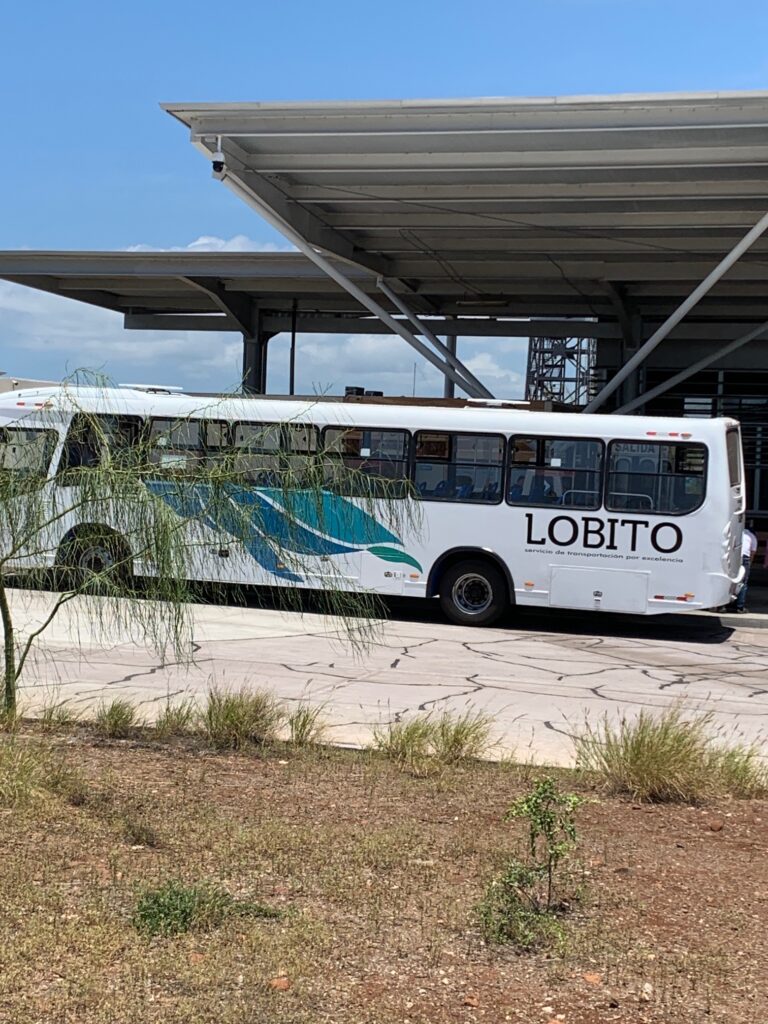

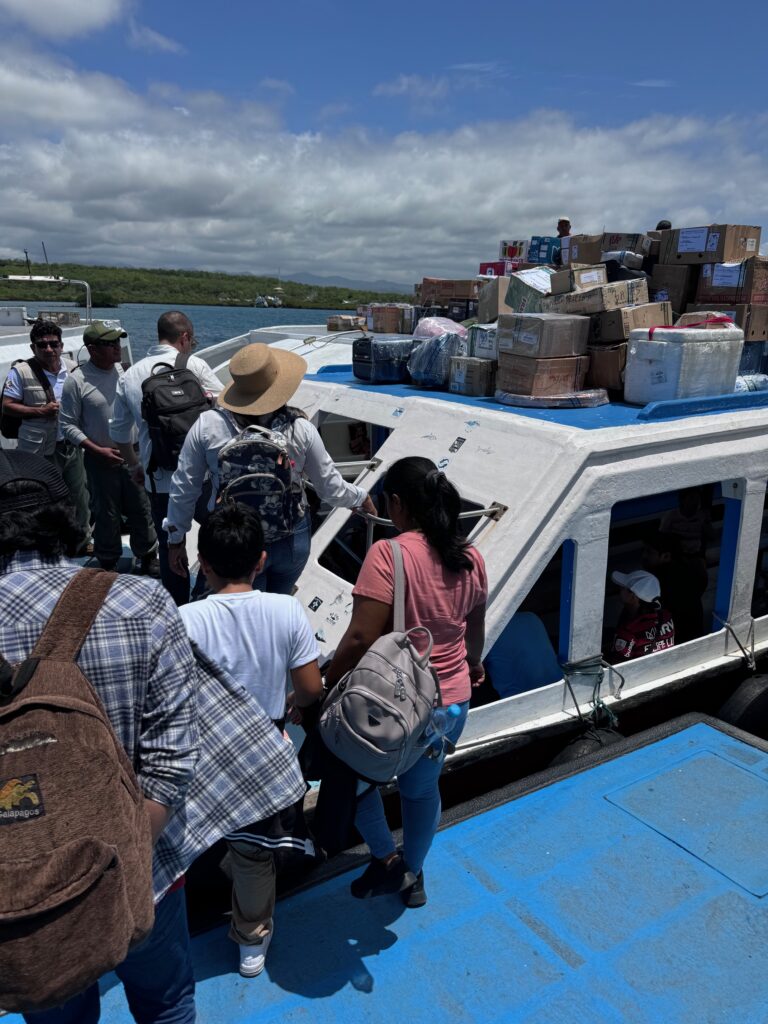

We had to take two buses, a canal ferry boat and a taxi to get from the airport to our hotel in Puerto Ayora. Total travel time was 1.5 hours. Total cost was $11 pp for the two buses and ferry boat ride. Taxi ride was $1.50.
Inter Island Transportation
Floreana, Isabela, San Cristobal and Santa Cruz are the only inhabited islands in the Galapagos. Floreana is the least populated while Santa Cruz is the most. There are two modes of transportation to move between Isabela, San Cristobal and Santa Cruz islands – ferry boats and planes. Floreana is only reachable by ferry boats.
Port Taxes and X-Ray Scanning
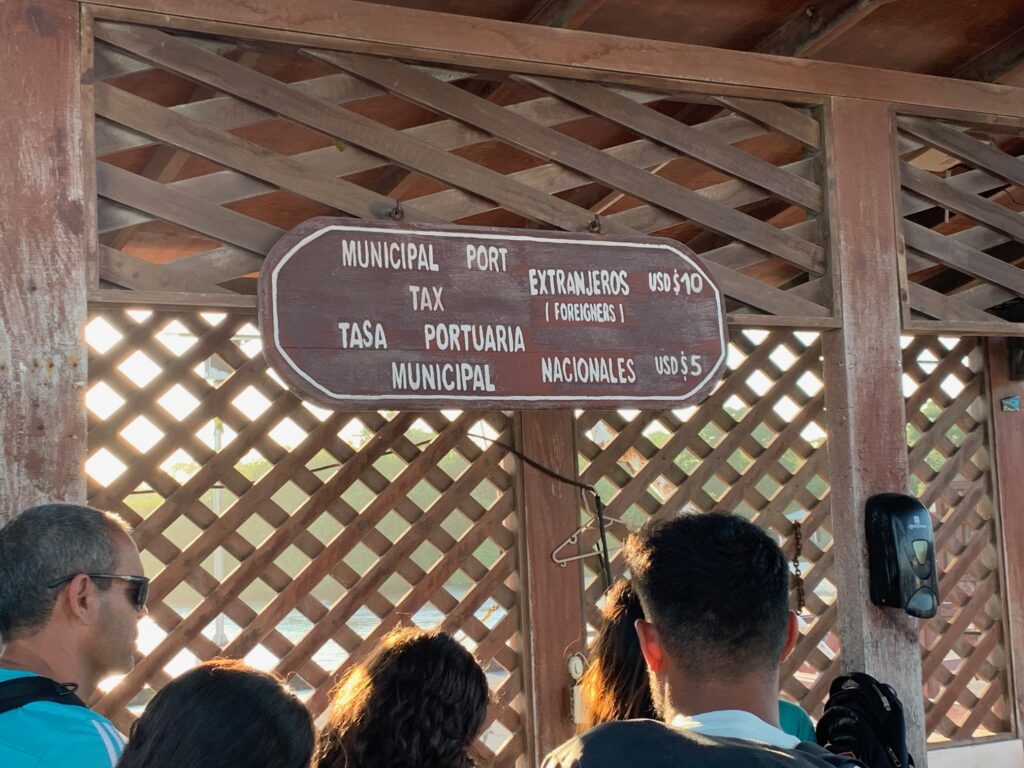

Isabela and Santa Cruz islands impose a port tax while San Cristobal does not. For Santa Cruz, it is $1 pp port tax whether you are arriving or leaving. Isabela imposes a $10 pp port tax on arrival (we have no information about leaving as we got on the 6AM ferry boat when the port office was closed).
All three islands have an X-ray machine at the port to scan visitor baggage whether they are arriving or leaving.
Water Taxis
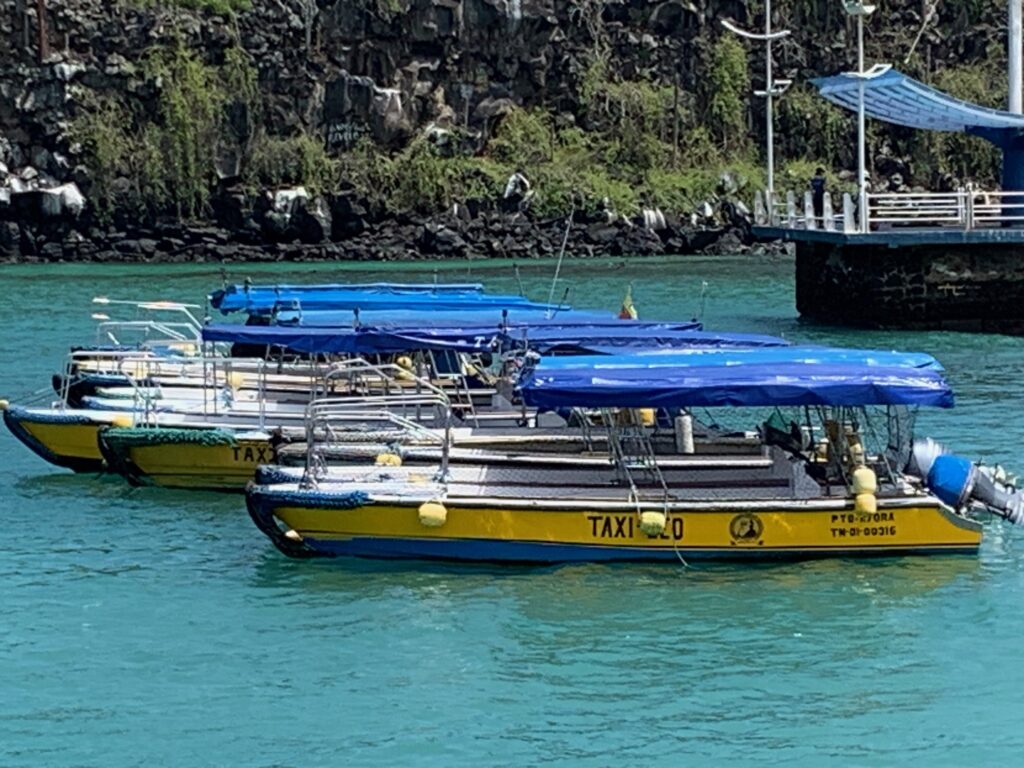

Ferry boats do not moor at the ports. Instead, they are out in deeper water but still within the marina. So ferry boat passengers would have to board a water taxis so they can be taken from the port to the ferry boat. The water taxi ride is $1 pp. You will have to two water taxi rides whenever you take a ferry boat, one to get on and one to get off the ferry boat.
You need to be nimble enough to be able to move from the water taxi bow (front) to the ferry boat stern (back). Though both vessels (water taxi and ferry boat) are tied together, both may be bobbing up and down when the water is not calm.
Ferry Boats
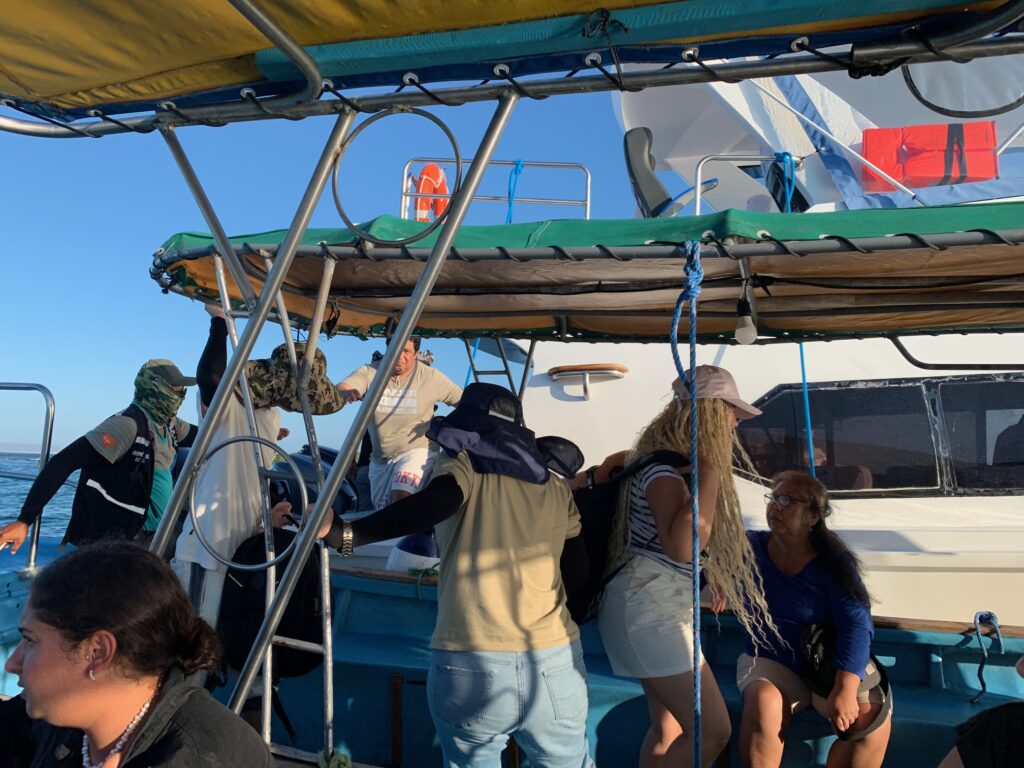

Santa Cruz is in between Isabela and San Cristobal. Floreana is south of Santa Cruz. All public ferry boats either originate from or go to Santa Cruz (Puerto Ayora to be exact). This mean if you want to go to any of the other three islands, you have to be at Puerto Ayora. There is no direct ferry boat between Floreana, Isabela and San Cristobal.
For example, if you want to go from Isabela to San Cristobal and vice versa, you would have to go to Puerto Ayora first then get on another ferry boat to San Cristobal. Each ferry ride costs $30 USD pp. The price is the same across all tour agencies as public ferry fares are regulated. So there is no need to shop around to get the lowest price. However, you may want to at least find out what kind of boat you will be getting on as not all ferry boats are the same. Some are older than others.
Ferry boats typically leave at 6 AM and 3 PM. However, you must physically check in an hour early. For the morning departure, you go to the boat dock directly at 5AM as the ferry boat office would still be closed. For the afternoon departure, you check in at the ferry boat office at 2PM.
The next more important thing to remember besides the check in time is the name of the ferry boat. Passengers are handed a tag on a lanyard at check in. The tag shows the boat’s name. So make sure your tag is correct.
Port officials or the military will hold a master list of passenger names per ferry boat. They will check off your name before you are allowed to proceed to the designated water taxi loading dock.
It takes around two hours to go between Santa Cruz and Isabela or Santa Cruz and San Cristobal. The ferry ride between Santa Cruz and Floreana takes about 1.5 hours.
If you need to get to San Cristobal from Isabela and vice versa on the same day, you would have to go on the 6 AM boat to Puerto Ayora first. Then you will have six hours to kill in before checking in at 2 PM. Some tour companies that work with the ferry boats will allow transient passengers to leave their luggage at their office in between ferry rides.
Ferry boats typically have capacities between 20 and 40 passengers so it is not a big boat. Sometimes one ferry boat makes the journey, sometimes three. It depends on the number of passengers. Best to reserve your ferry boat seat as soon as you can. Most of the time they want the boats to be full for the trip or they would not make the trip at all (unless they need to return because the going the other way is full). If you wait until the last minute, chances are the boat is already full or that there are not enough passengers such that it would not make the trip. Either way, you will be stuck for that day wherever you are.
Flights
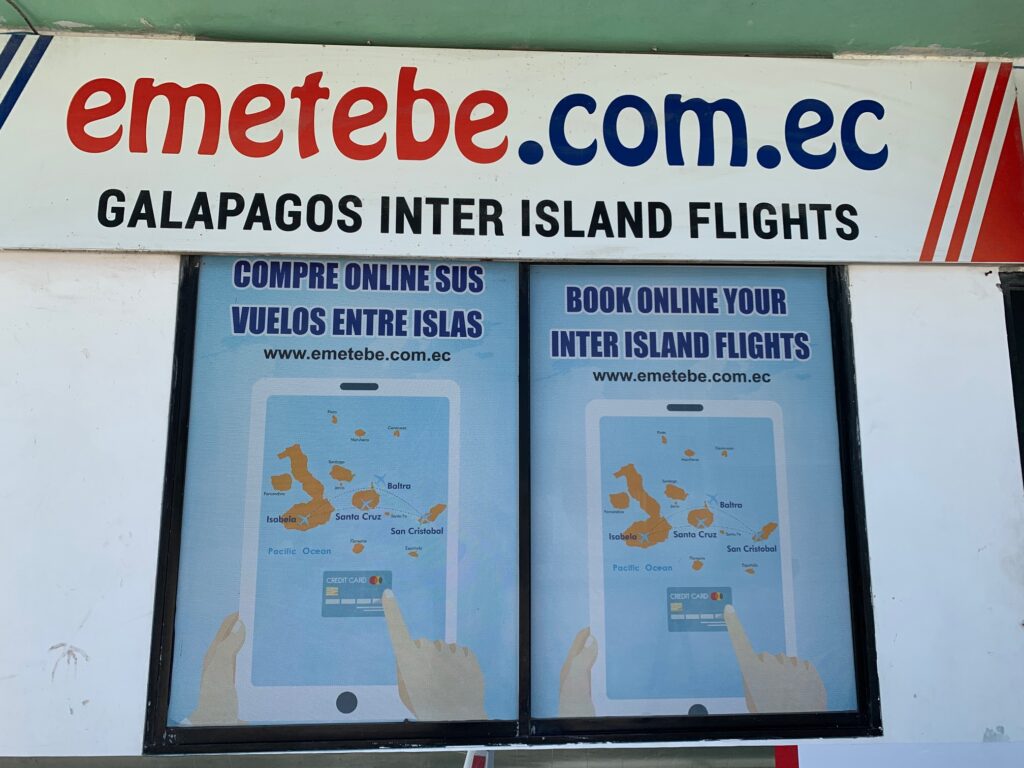

We saw a company in Isabela offering flights between Isabela, San Cristobal and Santa Cruz. According to one couple that used this service, the cost was around $100 pp to fly from San Cristobal to Isabela. The couple said that the airplane was a small turboprop.
Our Logistical Mistake
We already booked a roundtrip airplane ride between Quito and Isla Baltra before finding out that San Cristobal also has a commercial airport. So we had to return to Santa Cruz after visiting San Cristobal. Had we known about this airport, we would have booked two one way flights. One flying into Isla Baltra and the other flying out of San Cristobal. This way, we would not have to waste a day to take a ferry boat back to Santa Cruz from San Cristobal.
Tours
Though each inhabited island has tour companies, Santa Cruz has the most. Santa Cruz basically sits in the middle of the Galapagos islands. That is why there is a lot of tour companies here. Isabela and San Cristobal are too far from the other uninhabited islands such that the whole day would be spent traveling. You may want to spend more time in Santa Cruz if you are interested in doing a lot of tours.
If you are interested in liveaboard tours (cruise), you will find these tour agencies in Santa Cruz also. A guide that used to work on cruise boats for over 20 years told us there there are three cruise ships operating in the Galapagos that carry 100 guests and the rest are cruise boats that carry around 16 guests.
Cruise ships/boats either go East, North or West of Santa Cruz. We were surprised to hear from the former cruise boat employee turned guide that if we get on each eight day cruise (going East, North and West), we would only see 75% of the Galapagos islands.
There are also different animals to see in each cruise. The guide’s example was we should go on a cruise that heads over to Isabela if we wanted to see penguins.
Weather
Our host in Santa Cruz said that the weather in Galapagos is hot and hotter.
The Galapagos Islands lie around the equator so the sun’s rays are intense. The weather slightly differ from island to island according to our taxi driver in San Cristobal. He said it is slightly hotter in Santa Cruz compared to San Cristobal. We felt it was hottest in Isabela during our trip.
Hotter season runs from January to June. It was like Florida weather in the summer during our visit. Hot, humid and sticky. It is one of those places where you would want to take a shower twice a day if you are out and about. The nights though were better especially if there was a breeze. The only blessing about this time of the year is that there is less chance of rain.
Hot season is starts in July and is the beginning of the rainy season up to December. The temperature goes down a little (still hot but not hotter) because of the rain. However the seas become rougher. Tour companies continue to operate though.
What To Bring


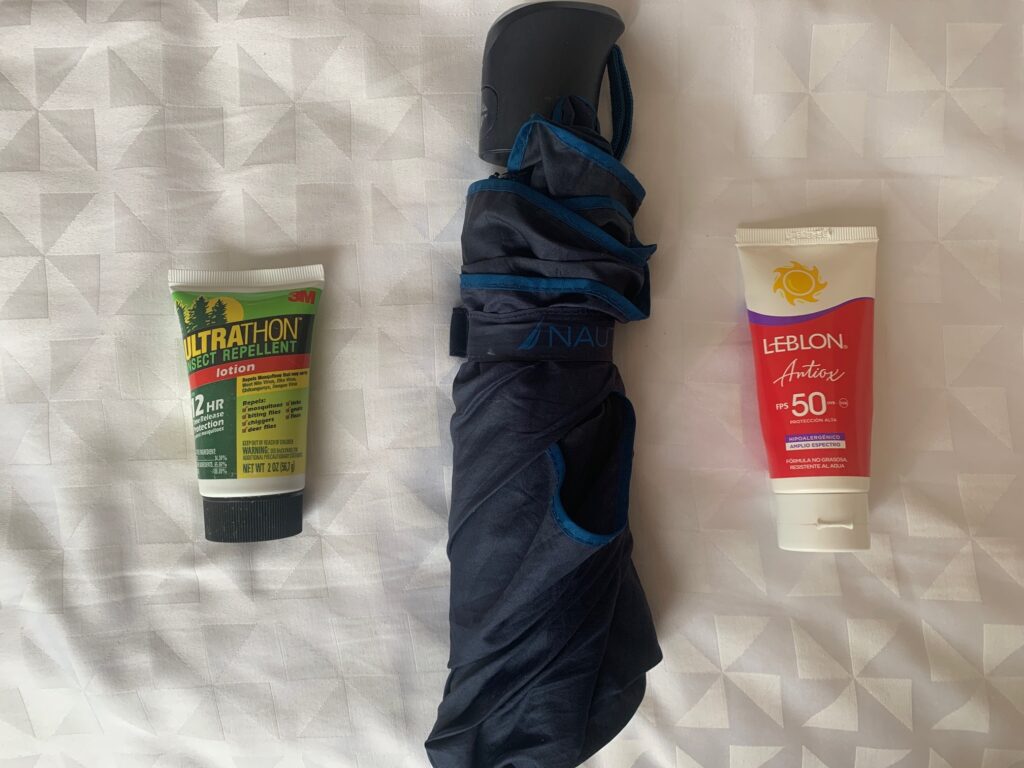

Because majority of activities in the Galapagos is water related, it is best to bring all essential items for sun protection. There is no need to bring snorkels and fins as those can be rented on the three big islands. You may want to bring your own personal floatation device (PFD) if you are not a good swimmer as we did not notice those being rented in most of the rental shops. It may be available at tour companies.
Besides sunscreen lotion and sunglasses, a wide brimmed hat with back of the neck cover is a must. These type of hats are commonly sold at stores on the islands if you do not have one. Baseball caps may look cool but does not provide adequate coverage and protection.
A rash guard or slightly tight fitting UPF long sleeve shirt provides two benefits while doing water activities. It covers your body and arms from the sun while in the water. It also keeps you cool when you get out of the water.
Perhaps not commonly thought about is an umbrella. Chances are you will be doing a lot of walking in the Galapagos. An umbrella provides portable shade during those walks. It really makes a big difference in cutting down the intense sun rays.
Large biting flies that draw blood are common in the Galapagos. They may not be everywhere but you will definitely get bit by one or more. Besides biting flies, there are other insects that bite or perhaps sting that will definitely make you itch and scratch until your skin is raw. Insect repellant may help repel some insects but not all. An anti-itch cream may provide some relief from being itchy.
Do not forget to bring cash. Ecuador’s currency is the US $. It is one way of avoiding any foreign ATM fees. Bringing lots of $1 bills would also be helpful in paying taxis. Small denominations such as $5 and $10 bills would also come in handy for eating at not so fancy but still sumptuous restaurants (see “Where to Eat” section in each of our write-up for Isabela, San Cristobal and Santa Cruz).
Summary
The Galapagos is a wonderful destination if you do not mind the heat and humidity. There is no other place on earth that we know of where animals and humans live in complete harmony. It is a very environmentally conscious place as well. People are required to take their trash with them as there are no trash cans to be found on the streets. All the hotels we stayed in Isabela, San Cristobal and Santa Cruz provided drinking water so we did not have to purchase bottled water. We did not even see any plastic bottles floating on the water.
The Galapagos is a very affordable destination if you are not going to do any tours. The beaches may not be as white and fine or the water as crystal clear as those in the Pacific or Caribbean, but it still enjoyable nonetheless. Though the beaches only have sporadic hard corals, there are still colorful fish to look at. It is entertaining to watch the pelicans and boobies dive bomb for fish and sea lions and penguins swim effortlessly in the water.
Overall, the Galapagos is a unique place. Regardless of what you have read here, come to the Galapagos without any expectations and you will surely have a more enjoyable time.

